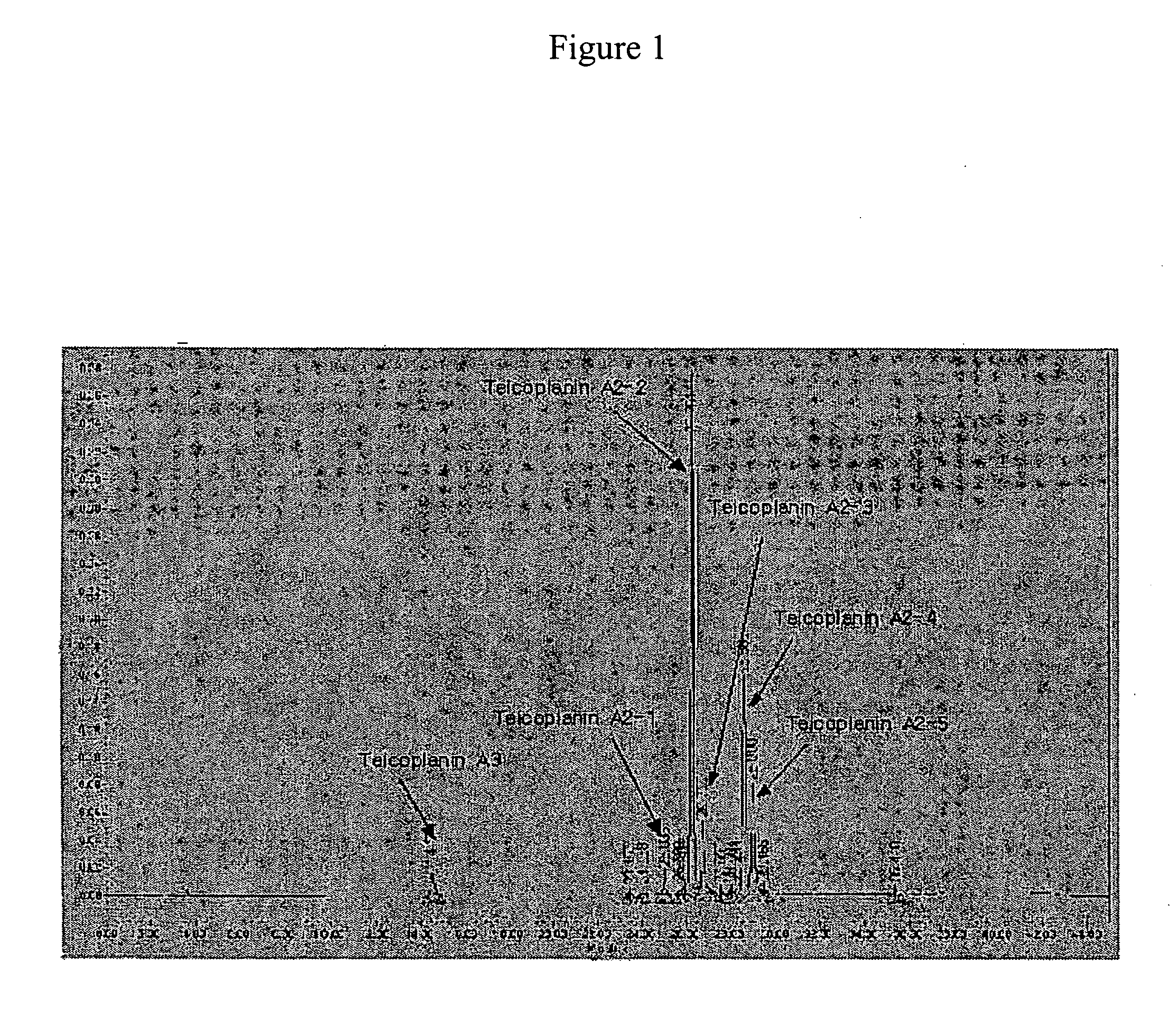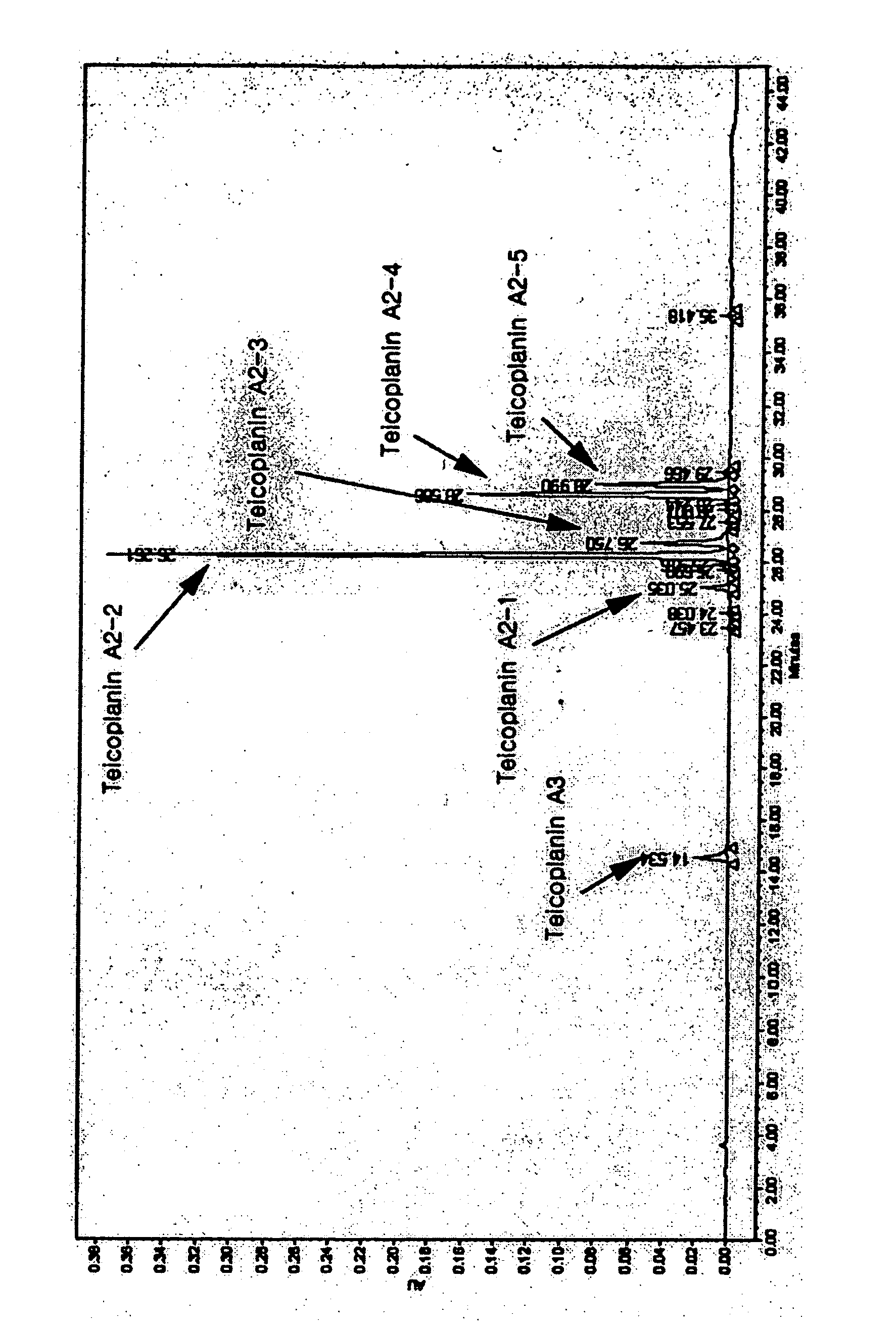Method of producing teicoplanin
a technology of teicoplanin and teicoplanin, which is applied in the field of producing teicoplanin, can solve the problems of antibacterial resistance microorganisms spreading, the purification method is complicated, and the sephadex lh 20 is too expensive to apply in a large scale production, and achieves the effect of safe and inexpensive methods for producing highly pure teicoplanin
- Summary
- Abstract
- Description
- Claims
- Application Information
AI Technical Summary
Benefits of technology
Problems solved by technology
Method used
Image
Examples
example 1
[0055] 160 L of culture broth of Actinoplanes teichomyceticus DKB 53 was filtered using a drum filter to remove a mycelium therefrom, and 120 L of filtrate was obtained. The filtrate was analyzed by an OPTIMAPAK® C18 (4.6×250 mm, RStech Co.) HPLC column. Teicoplanin 1st International Standard (National Institute for Biological Standards and Control, Hertfordshire UK) was used as a reference standard for quantification. With respect to this, the content and total amount of teicoplanin in the filtrate were 4.2 g / L and 504 g, respectively. Additionally, the pH of the filtrate was 6.8. Four L of methanol was added to 20 L of filtrate (teicoplanin 84 g), and the resulting mixture was applied onto a column (15×50 cm) packed with 4 L of DOWEX OPTIPORE SD-2 at a flow rate of 2 BV (bed volume) / hr without controlling the pH of the resulting mixture. Subsequently, 4 BV (16 L) of 30% (v / v) methanol was loaded at the flow rate of 4 BV / hr into the column to wash the resin packed in the column. Fu...
example 2
[0056] 2 L of isopropanol was added to 20 L of filtered culture broth (teicoplanin 84 g) according to Example 1, and the resulting mixture was applied on a column (15×50 cm) packed with 4 L of DOWEX OPTIPORE SD-2 at a flow rate of 2 BV / hr. Subsequently, 4 BV (16 L) of 15% (v / v) isopropanol was loaded at a flow rate of 4 BV / hr into the column to wash the resin packed in the column. Further, 8 BV (32 L) of 40% (v / v) isopropanol, containing 0.15 M sodium chloride, was loaded into the column at a flow rate of 4 BV / hr to elute teicoplanin. It was confirmed by analysis of an eluate using HPLC that the peak area of teicoplanin A2 was 81.7% of the total peak area. Furthermore, the amount of teicoplanin was 73.6 g, which meant that recovery of teicoplanin was 87.6% (refer to Table 1).
example 3
[0057] 4 L of methanol was added to 20 L of filtered culture broth according to example 1, and the resulting mixture was applied on a column (15×50 cm) packed with 4 L of Diaion HP 20 at a flow rate of 2 BV / hr. Subsequently, 4 BV (16 L) of 30% (v / v) methanol solution was loaded at a flow rate of 4 BV / hr into the column to wash the resin packed in the column. Further, 8 BV (32 L) of 60% (v / v) methanol solution, containing 0.15 M sodium chloride, was loaded into the column at a flow rate of 4 BV / hr to elute teicoplanin. It was confirmed by analysis of an eluate using HPLC that the peak area of teicoplanin A2 was 83.4% of a total peak area. Furthermore, the amount of teicoplanin was 70.7 g, which meant that recovery of the teicoplanin was 84.2% (refer to Table 1).
PUM
| Property | Measurement | Unit |
|---|---|---|
| Fraction | aaaaa | aaaaa |
| Fraction | aaaaa | aaaaa |
| Acidity | aaaaa | aaaaa |
Abstract
Description
Claims
Application Information
 Login to View More
Login to View More - R&D
- Intellectual Property
- Life Sciences
- Materials
- Tech Scout
- Unparalleled Data Quality
- Higher Quality Content
- 60% Fewer Hallucinations
Browse by: Latest US Patents, China's latest patents, Technical Efficacy Thesaurus, Application Domain, Technology Topic, Popular Technical Reports.
© 2025 PatSnap. All rights reserved.Legal|Privacy policy|Modern Slavery Act Transparency Statement|Sitemap|About US| Contact US: help@patsnap.com


